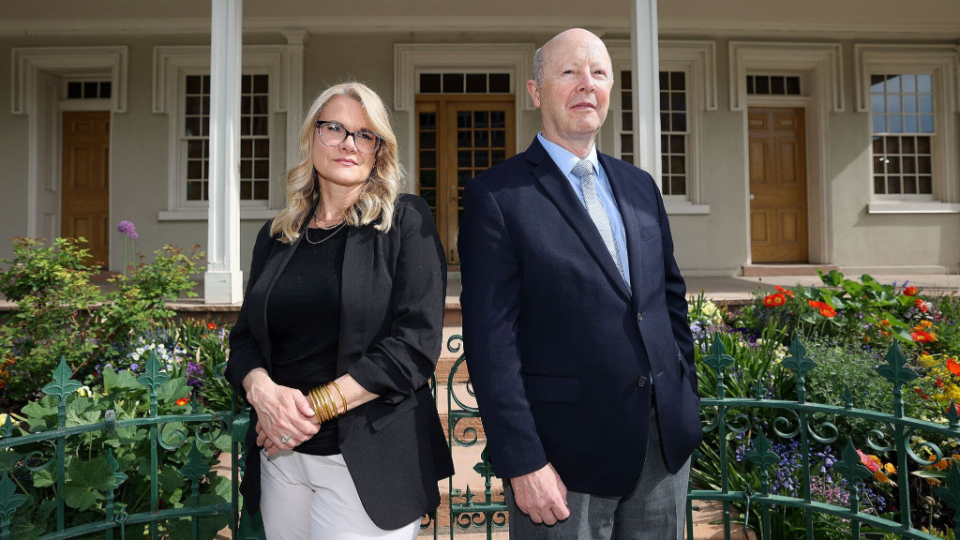
Mountain-Meadows-Massacre
Barbara Jones Brown and Richard E. Turley Jr., co-authors of “Vengeance is Mine,” pose for a portrait outside of the Beehive House in Salt Lake City on Friday, May 12, 2023. Photo by Kristin Murphy, courtesy of Church News.Copyright 2023 Deseret News Publishing Company.
This story appears here courtesy of TheChurchNews.com. It is not for use by other media.
By Trent Toone, Church News
A desire to be more transparent was the initial motivation behind the idea to publish a book on perhaps the darkest episode in the history of The Church of Jesus Christ of Latter-day Saints.
For Richard E. Turley Jr., author and historian, that meant a deep dive into the Mountain Meadows Massacre.
“I thought, ‘OK, let’s take the worst incident and look at it straight on. Let’s shine a bright light into a dark corner. Let’s take on a topic that was previously taboo and look at it, and let the chips fall where they may,’” Turley said. “If we can tackle that subject, then we can tackle any subject.”
Jesus said in the New Testament, “Ye shall know the truth, and the truth shall make you free,” (see John 8:32). The only way to confront such a terrible topic, Turley continued, is “not to cover it up” but to “dig deeper than anyone has ever done before to bring the full truth of it out.”
In 2008, Turley and co-authors Ronald W. Walker and Glen M. Leonard published “Massacre at Mountain Meadows,” which provides a clear and accurate account of the horrific event.
Nearly 15 years and hundreds of thousands of words later, Turley and co-author Barbara Jones Brown have now completed a sequel, “Vengeance is Mine: The Mountain Meadows Massacre and Its Aftermath.”
Turley and Brown spoke about their experience with the project as featured guests on the Church News podcast. They hope when people study the Mountain Meadows Massacre, they don’t attempt to justify, condone, rationalize or shift the blame, but instead view the event in an open, honest and transparent way.
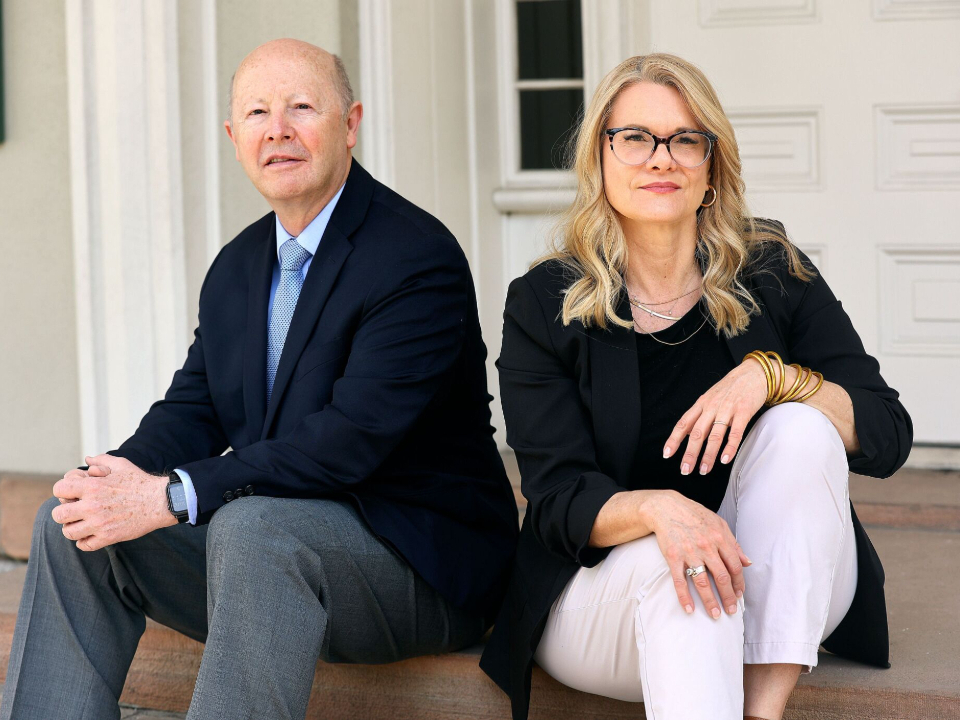
Mountain-Meadows-Massacre
Richard E. Turley Jr. and Barbara Jones Brown, co-authors of “Vengeance is Mine,” pose for a portrait outside of the Beehive House in Salt Lake City on Friday, May 12, 2023. Photo by Kristin Murphy, courtesy of Church News.Copyright 2023 Deseret News Publishing Company.“We’ve often said that no one alive today bears any responsibility for carrying out the massacre or planning it, but we are all responsible for how we treat this topic,” Turley said. “If we try to justify it or condone it or vilify the victims or blame others who are not primarily responsible for it, then we haven’t been transparent, we haven’t been honest, we haven’t been straightforward.”
Knowing the truth has helped descendants on both sides to find some reconciliation and healing, Brown said.
“That’s why it’s so important just to face all history, even the troubling history, and be able to learn and grow and actually be better because of knowing it,” she said.
What Is the Mountain Meadows Massacre?
In 1857, an emigrant train headed for California was initially attacked on September 7 at a place called the Mountain Meadows in southwestern Utah.
Following a five-day siege, some 100 men, women and children were massacred by a group of more than 50 local Southern Utah Mormon militiamen. They were aided by Paiute allies whom they had roped into participating so they could ultimately blame the atrocity on them and deflect blame from themselves.
The perpetrators spared 17 children, ages 6 and under, who were eventually returned to relatives.
Monuments and Remembrance
The Church has made great efforts to preserve the site and area, as well as heal wounds caused by the massacre because Latter-day Saints were the perpetrators.
In 1999, then-President Gordon B. Hinckley joined with descendants of the victims to dedicate a monument at the site.
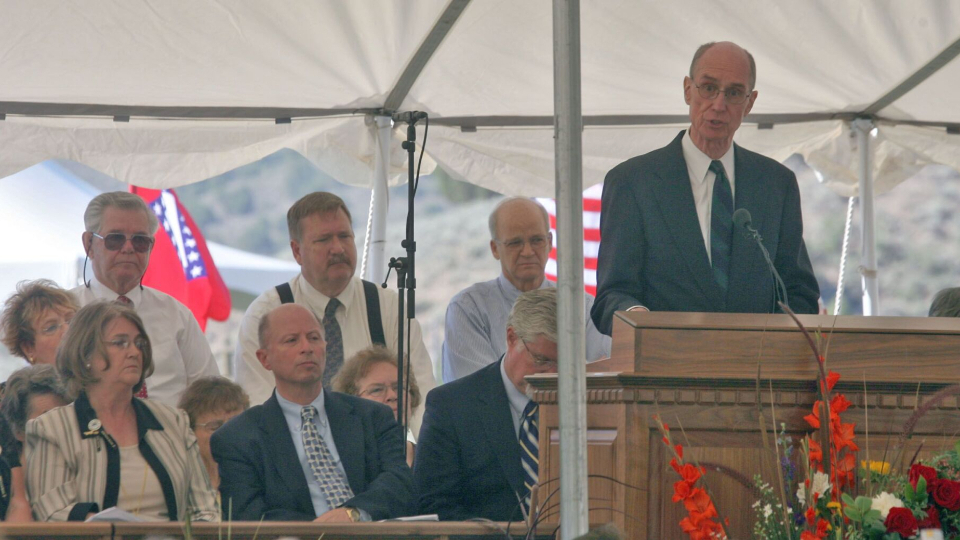
Mountain-Meadows-Massacre
President Henry B. Eyring, then a member of the Quorum of the Twelve Apostles, speaks during an event marking the 150th anniversary of the Mountain Meadows Massacre at the memorial site near Enterprise, Utah, on Tuesday, September 11, 2007. Photo by Jason Olson, courtesy of Church News.Copyright 2023 Deseret News Publishing Company.President Henry B. Eyring, then a member of the Quorum of the Twelve Apostles, spoke at the sesquicentennial of the massacre on September 11, 2007.
“The gospel of Jesus Christ that we espouse abhors the cold-blooded killing of men, women and children. Indeed, it advocates peace and forgiveness. What was done here long ago by members of our Church represents a terrible and inexcusable departure from Christian teaching and conduct. We cannot change what happened, but we can remember and honor those who were killed here,” said President Eyring, who now serves as second counselor in the First Presidency.
“We express profound regret for the massacre carried out in this valley 150 years ago today and for the undue and untold suffering experienced by the victims then and by their relatives to the present time.”
The Mountain Meadows Massacre site has become a special place for Brown.
“Each time I go there, I feel a promise in my heart that I will always tell their story so that they are never forgotten and so their people know what happened to them,” she said. “I hope that after reading our book, people will come to learn more about the victims ... and honor them when they visit the site.”
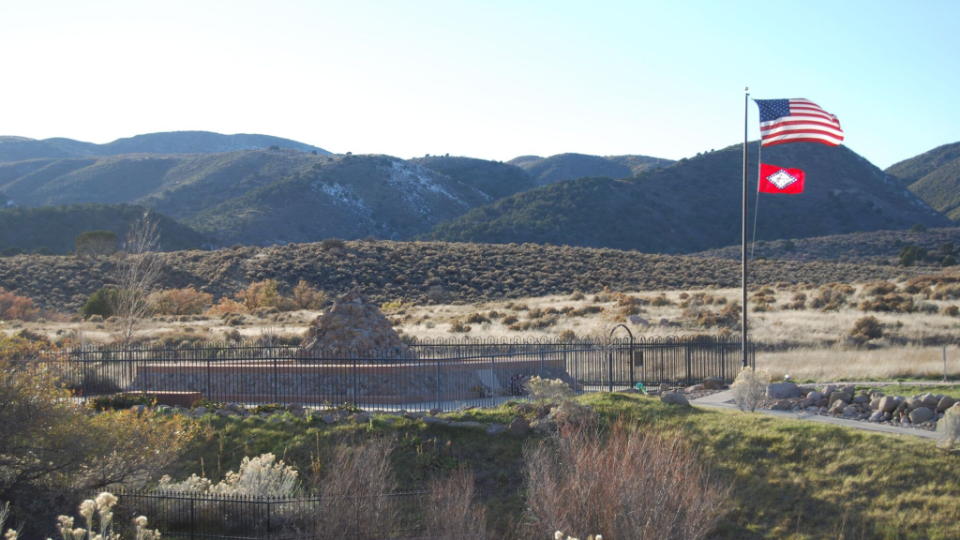
Mountain-Meadows-Massacre
A monument built by The Church of Jesus Christ of Latter-day Saints honors victims of the Mountain Meadows Massacre near Enterprise, Utah. Photo by Trent Toone, courtesy of Church News.Copyright 2023 Deseret News Publishing Company.Key Points, New Findings
The writer-historians spent years going through journals, newspaper articles, letters, trial transcripts and other historical documents to provide a detailed, contextual record. Here are some of their key points and new findings:
- The historians believe that Jacob Hamblin’s estimated victim count — based on his guess when burying the victims’ remains a year after the massacre — was exaggerated. Hamblin estimated 120 and that was the count for many decades. People who counted the bodies immediately after the crime estimate it closer to 100.
- Historical evidence shows that Brigham Young did not know about the massacre in advance and did not order it. He sent a letter instructing Church leaders to let the immigrants go in peace. John D. Lee, a major participant in the massacre, later lied to Brigham Young in a report. Brigham Young’s understanding of what happened was gradual over many years.
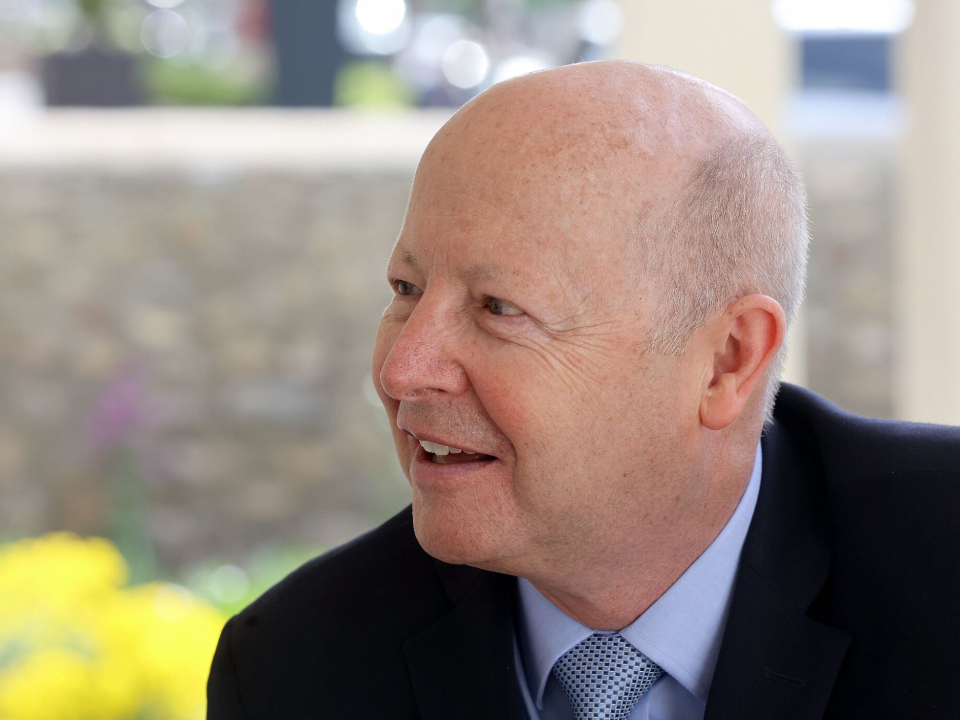
Mountain-Meadows-Massacre
Richard E. Turley Jr. talks during an interview outside of the Beehive House in Salt Lake City on Friday, May 12, 2023. Turley and Barbara Jones Brown co-wrote “Vengeance is Mine.” Photo by Kristin Murphy, courtesy of Church News.Copyright 2023 Deseret News Publishing Company.- While Brigham Young had nothing to do with the attack, he did use violent rhetoric in his communications. It was not the Church leader’s intention to harm anyone, but with a U.S. Army marching to occupy Utah Territory, Brigham Young initiated a series of attacks on supply trains and encouraged multiple immigrant cattle raids. In the case of Mountain Meadows, something went awry, the historians said.
- In 1859, Brigham Young wanted the case investigated and encouraged the suspects be tried in federal courts. “But for reasons we’ll explain in the book, political reasons, no one in the federal government accepts that offer from him until 1876,” Turley said. Lee was the only massacre perpetrator executed in 1877. Nine other men were indicted for the crime; some were taken into custody but let go due to insufficient evidence while others eluded capture, the historians said.
- Part of the cover-up included blaming the massacre on Paiute Indians. “The Paiute people for generations have also been victims in that the blame for this has been laid on their heads when it was the white settlers who made this decision and carried it out,” Brown said. “That’s another thing we hope to change through our book, to show who should really bear the blame.”
Finding Healing, Reconciliation
The co-authors described working on the longterm project as an “incredibly emotionally-trying experience.”
Studying the topic in great detail for more than three decades not only at times sickened Turley and brought him to tears, it also gave him nightmares.
Brown discovered that one of her direct ancestors, William S. Holly, was a perpetrator at the massacre.
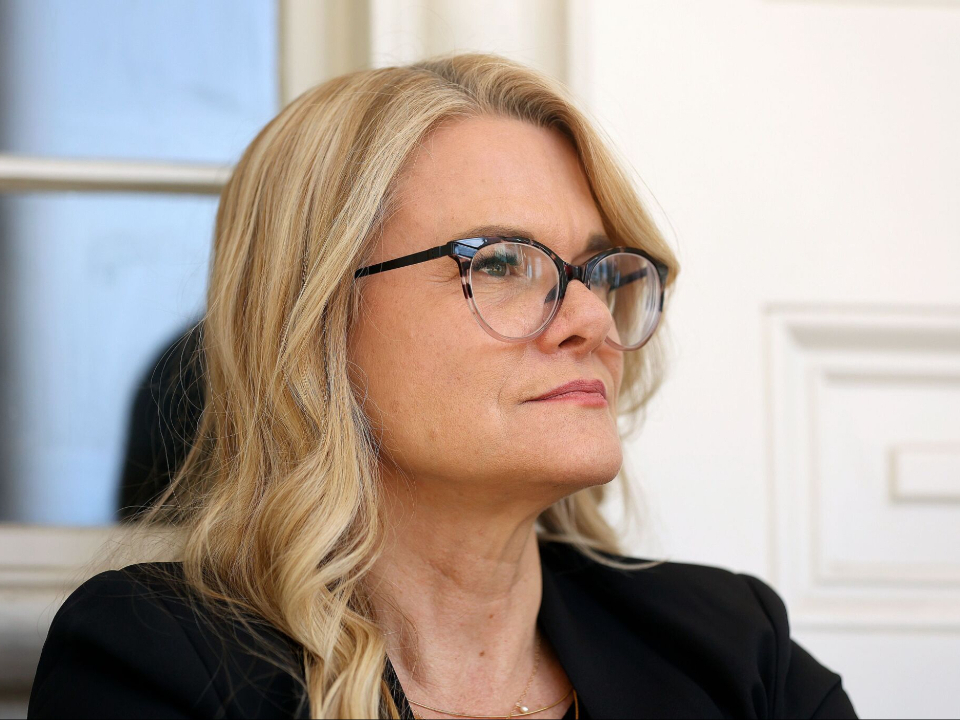
Mountain-Meadows-Massacre
Barbara Jones Brown listens during an interview outside of the Beehive House in Salt Lake City on Friday, May 12, 2023. Brown and Richard Turley co-wrote “Vengeance is Mine.” Photo by Kristin Murphy, courtesy of Church News.Copyright 2023 Deseret News Publishing Company.A desire to face the truth, right the wrongs and bring healing to all involved fueled the writer-historians to keep going. Some of their most meaningful moments came when they met descendants of the victims and offered sincere apologies for what happened. The relatives of the victims appreciated the gesture and encouraged Turley and Brown to tell the story.
“They have asked us, ‘Please tell the story. Please make sure our ancestors are never forgotten and people know the truth about what happened to them,’ That, for me, has been the driving factor that has kept me going through this very difficult writing,” Brown said.
Learning about the massacre and associating with the descendants of the perpetrators and the victims has been a valuable experience for Turley and Brown.
“I’ve learned about the importance of healing and reconciliation,” Turley said. “It’s been deeply gratifying to me, and I know it has been for Barbara, in particular to meet with those who are the descendants of the victims, to understand them and their backgrounds, to understand their ancestors, and to recognize that the people who came into the Mountain Meadows in 1857 and were slaughtered were not evil people.”
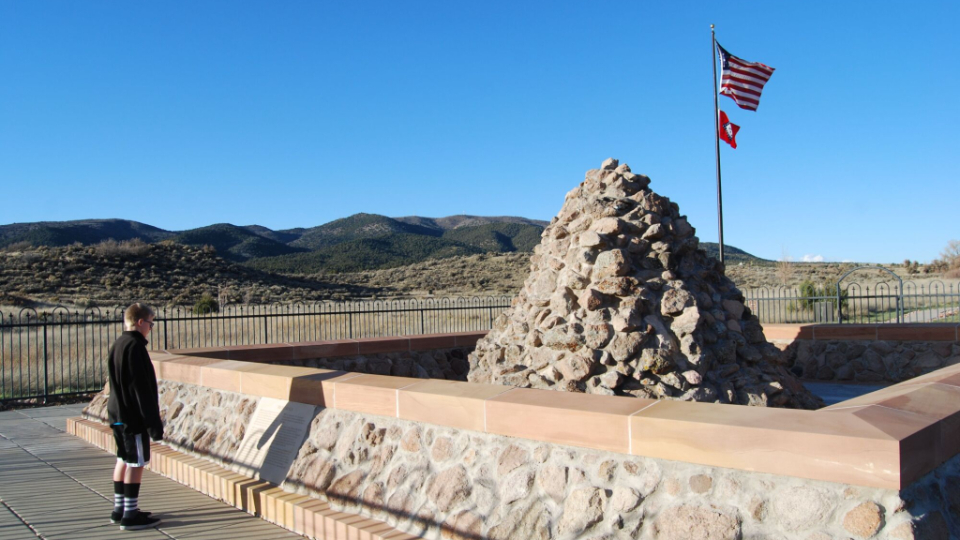
Mountain-Meadows-Massacre
A young visitor stands near the Church’s Mountain Meadows Massacre Historic Site. Photo by Trent Toone, courtesy of Church News.Copyright 2023 Deseret News Publishing Company.Lessons and Why it Matters Today
The writer-historians recommend not being afraid of history and troubling topics like the Mountain Meadows Massacre. Learning about it may be painful, but it can bring empathy and compassion.
“Ultimately,” Brown said, “it can only help us, I believe, to be better people.”
Another lesson is the importance of listening to other people and not vilifying those who are different. Along with that, there is a need to talk through subjects that are sometimes difficult.
“We sometimes find ourselves in situations that are not that much different. Perhaps we’re not looking to massacre someone, but we may be on social media, and then we may polarize, and we may begin to believe rumors about the other side, we begin to look at people who are not the same as us and consider them to be ‘the other,’” Turley said. “I think one of the most important things we can learn is that it’s important to listen to others who are different from ourselves, to be patient with them, not to vilify them, but to listen and try to respect them; to be civil.”
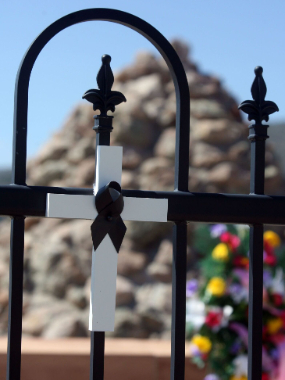
Mountain-Meadows-Massacre
A cross representing one of the victims of the Mountain Meadows Massacre is placed on the fence during an event marking the 150th anniversary of the horrific atrocity at the memorial site near Enterprise, Utah, Tuesday, September 11, 2007. Photo by Jason Olson, courtesy of Church News.Copyright 2023 Deseret News Publishing Company.A third lesson — realize that all humans past and present, with the exception of Jesus Christ, are subject to failings, weaknesses and mistakes.
“We need to be able to recognize that even our ancestors, who we want to glorify often and turn into great heroes, may not be perfect,” Turley said. “We need to learn how to accept imperfection and not just look for perfection.”
The writer-historians cautioned against believing unverified stories that people are sometimes quick to accept in social media or a story passed down in family history.
“I’d encourage people to withhold judgment until they’ve received enough evidence to be quite confident of the conclusions,” Turley said.
Brown is sometimes asked how to respond if the massacre comes up or if you happen to meet the descendant of a victim. She recommends the following response.
“Just say you’re sorry that it happened,” Brown said. “That’s all that people generally want to hear. And it means so much to people to hear that, particularly descendants of victims.”
RELATED STORY
